2015 FORD EXPLORER Rear seats
[x] Cancel search: Rear seatsPage 2 of 596

Introduction 10
Child Safety 18
Child seat positioning...................................20
Booster seats.........................................22
Installing child seats....................................25
Child safety locks......................................37
Safety Belts 38
Fastening the safety belts................................40
Safety belt height adjustment.............................43
Safetybeltwarninglightandindicatorchime..................44
Safety belt-minder.....................................44
Rear inflatable safety belt................................46
Child restraint and safety belt maintenance...................48
Personal Safety System 49
Supplementary Restraints System 50
Driver and passenger airbags.............................52
Front passenger sensing system...........................54
Side airbags..........................................57
Safety canopy curtain airbags.............................58
Crash sensors and airbag indicator.........................60
Airbag disposal........................................61
Keys and Remote Control 62
General information on radio frequencies.....................62
Remote control.......................................63
Keys...............................................63
Replacing a lost key or remote control.......................68
Table of Contents1
2015 Explorer(exp)
Owners Guide gf, 2nd Printing, September 2014
USA(fus)
Page 5 of 596
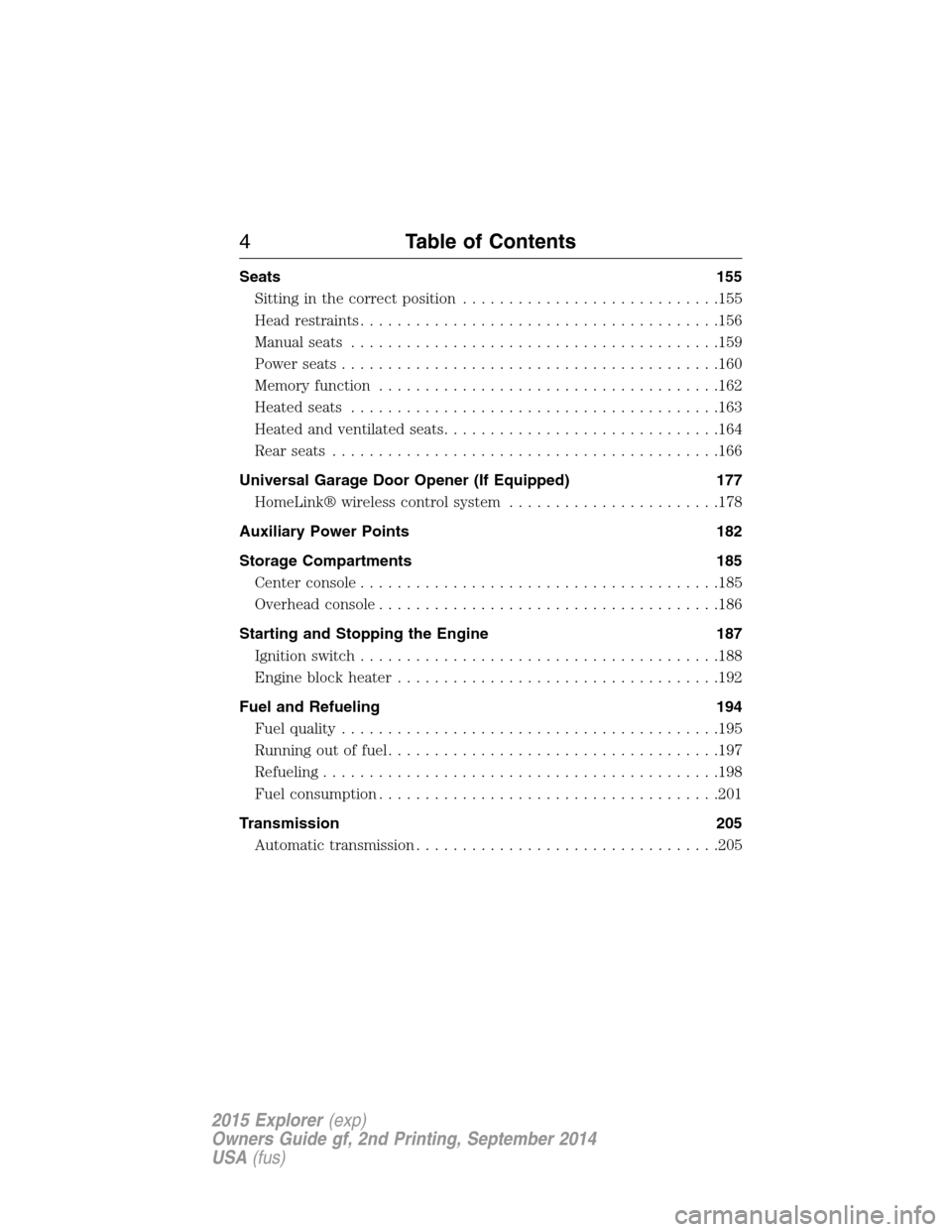
Seats 155
Sitting in the correct position............................155
Head restraints.......................................156
Manual seats........................................159
Power seats.........................................160
Memory function.....................................162
Heated seats........................................163
Heated and ventilated seats..............................164
Rear seats..........................................166
Universal Garage Door Opener (If Equipped) 177
HomeLink® wireless control system.......................178
Auxiliary Power Points 182
Storage Compartments 185
Center console.......................................185
Overhead console.....................................186
Starting and Stopping the Engine 187
Ignition switch.......................................188
Engine block heater...................................192
Fuel and Refueling 194
Fuel quality.........................................195
Running out of fuel....................................197
Refueling...........................................198
Fuel consumption.....................................201
Transmission 205
Automatic transmission.................................205
4Table of Contents
2015 Explorer(exp)
Owners Guide gf, 2nd Printing, September 2014
USA(fus)
Page 17 of 596
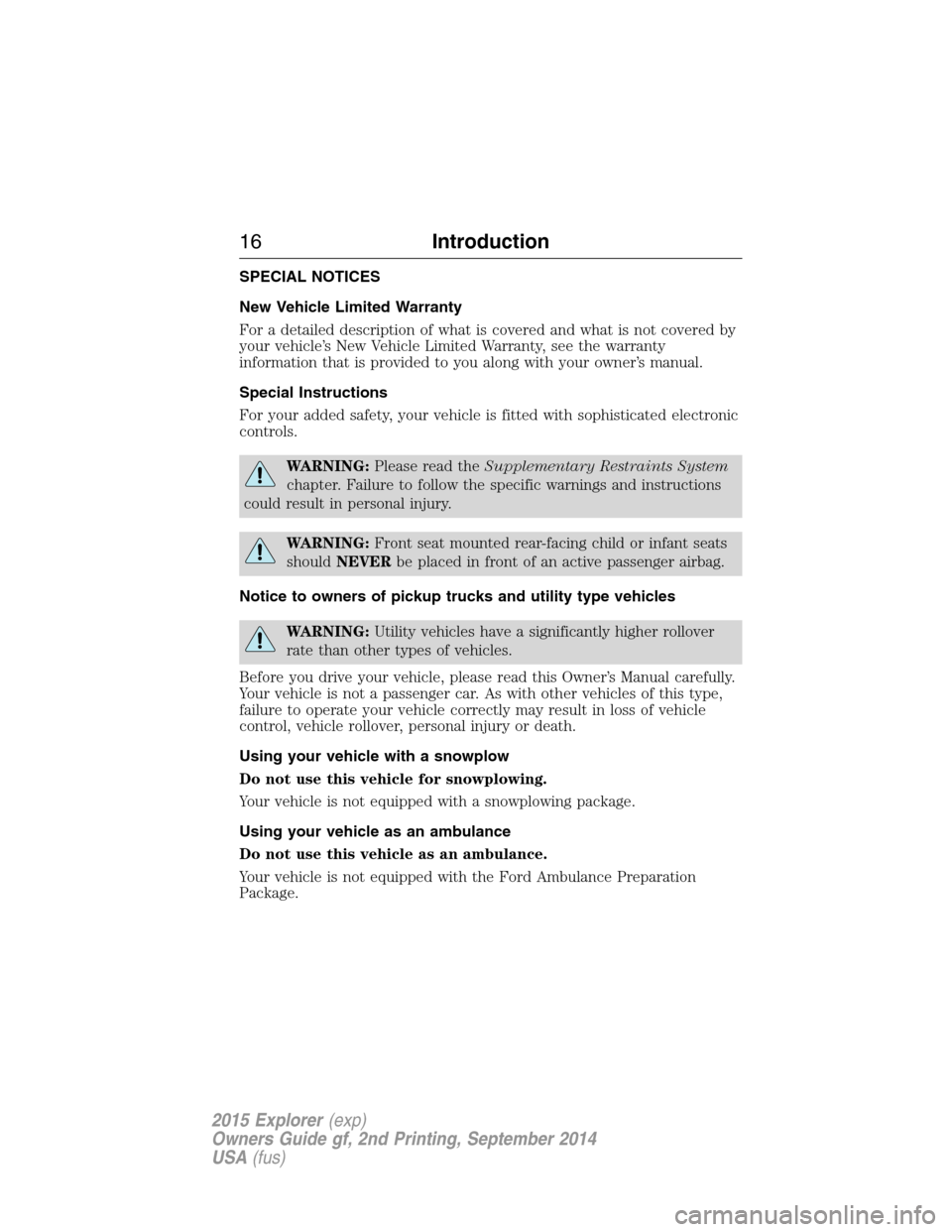
SPECIAL NOTICES
New Vehicle Limited Warranty
For a detailed description of what is covered and what is not covered by
your vehicle’s New Vehicle Limited Warranty, see the warranty
information that is provided to you along with your owner’s manual.
Special Instructions
For your added safety, your vehicle is fitted with sophisticated electronic
controls.
WARNING:Please read theSupplementary Restraints System
chapter. Failure to follow the specific warnings and instructions
could result in personal injury.
WARNING:Front seat mounted rear-facing child or infant seats
shouldNEVERbe placed in front of an active passenger airbag.
Notice to owners of pickup trucks and utility type vehicles
WARNING:Utility vehicles have a significantly higher rollover
rate than other types of vehicles.
Before you drive your vehicle, please read this Owner’s Manual carefully.
Your vehicle is not a passenger car. As with other vehicles of this type,
failure to operate your vehicle correctly may result in loss of vehicle
control, vehicle rollover, personal injury or death.
Using your vehicle with a snowplow
Do not use this vehicle for snowplowing.
Your vehicle is not equipped with a snowplowing package.
Using your vehicle as an ambulance
Do not use this vehicle as an ambulance.
Your vehicle is not equipped with the Ford Ambulance Preparation
Package.
16Introduction
2015 Explorer(exp)
Owners Guide gf, 2nd Printing, September 2014
USA(fus)
Page 20 of 596
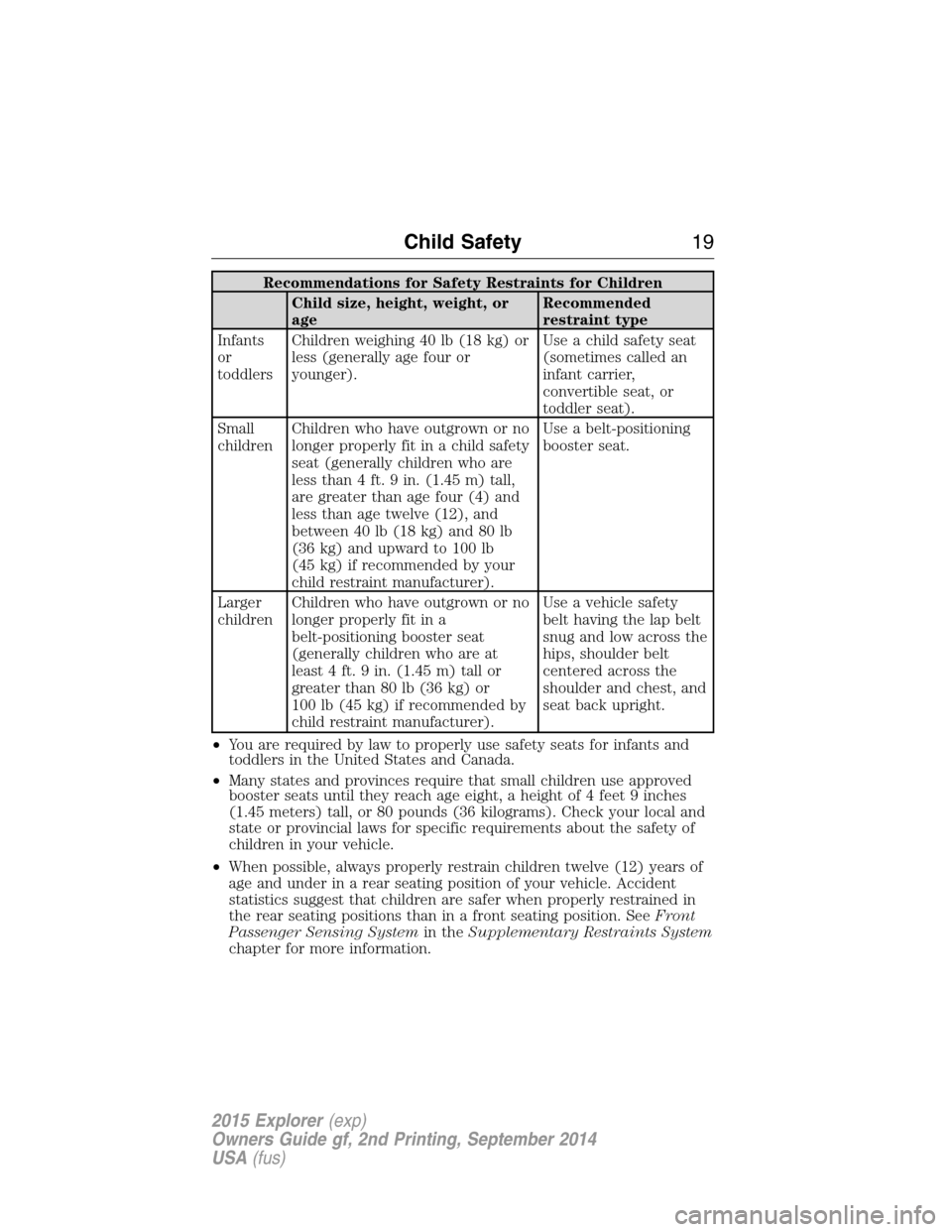
Recommendations for Safety Restraints for Children
Child size, height, weight, or
ageRecommended
restraint type
Infants
or
toddlersChildren weighing 40 lb (18 kg) or
less (generally age four or
younger).Use a child safety seat
(sometimes called an
infant carrier,
convertible seat, or
toddler seat).
Small
childrenChildren who have outgrown or no
longer properly fit in a child safety
seat (generally children who are
less than 4 ft. 9 in. (1.45 m) tall,
are greater than age four (4) and
less than age twelve (12), and
between 40 lb (18 kg) and 80 lb
(36 kg) and upward to 100 lb
(45 kg) if recommended by your
child restraint manufacturer).Use a belt-positioning
booster seat.
Larger
childrenChildren who have outgrown or no
longer properly fit in a
belt-positioning booster seat
(generally children who are at
least 4 ft. 9 in. (1.45 m) tall or
greater than 80 lb (36 kg) or
100 lb (45 kg) if recommended by
child restraint manufacturer).Use a vehicle safety
belt having the lap belt
snug and low across the
hips, shoulder belt
centered across the
shoulder and chest, and
seat back upright.
•You are required by law to properly use safety seats for infants and
toddlers in the United States and Canada.
•Many states and provinces require that small children use approved
booster seats until they reach age eight, a height of 4 feet 9 inches
(1.45 meters) tall, or 80 pounds (36 kilograms). Check your local and
state or provincial laws for specific requirements about the safety of
children in your vehicle.
•When possible, always properly restrain children twelve (12) years of
age and under in a rear seating position of your vehicle. Accident
statistics suggest that children are safer when properly restrained in
the rear seating positions than in a front seating position. SeeFront
Passenger Sensing Systemin theSupplementary Restraints System
chapter for more information.
Child Safety19
2015 Explorer(exp)
Owners Guide gf, 2nd Printing, September 2014
USA(fus)
Page 22 of 596
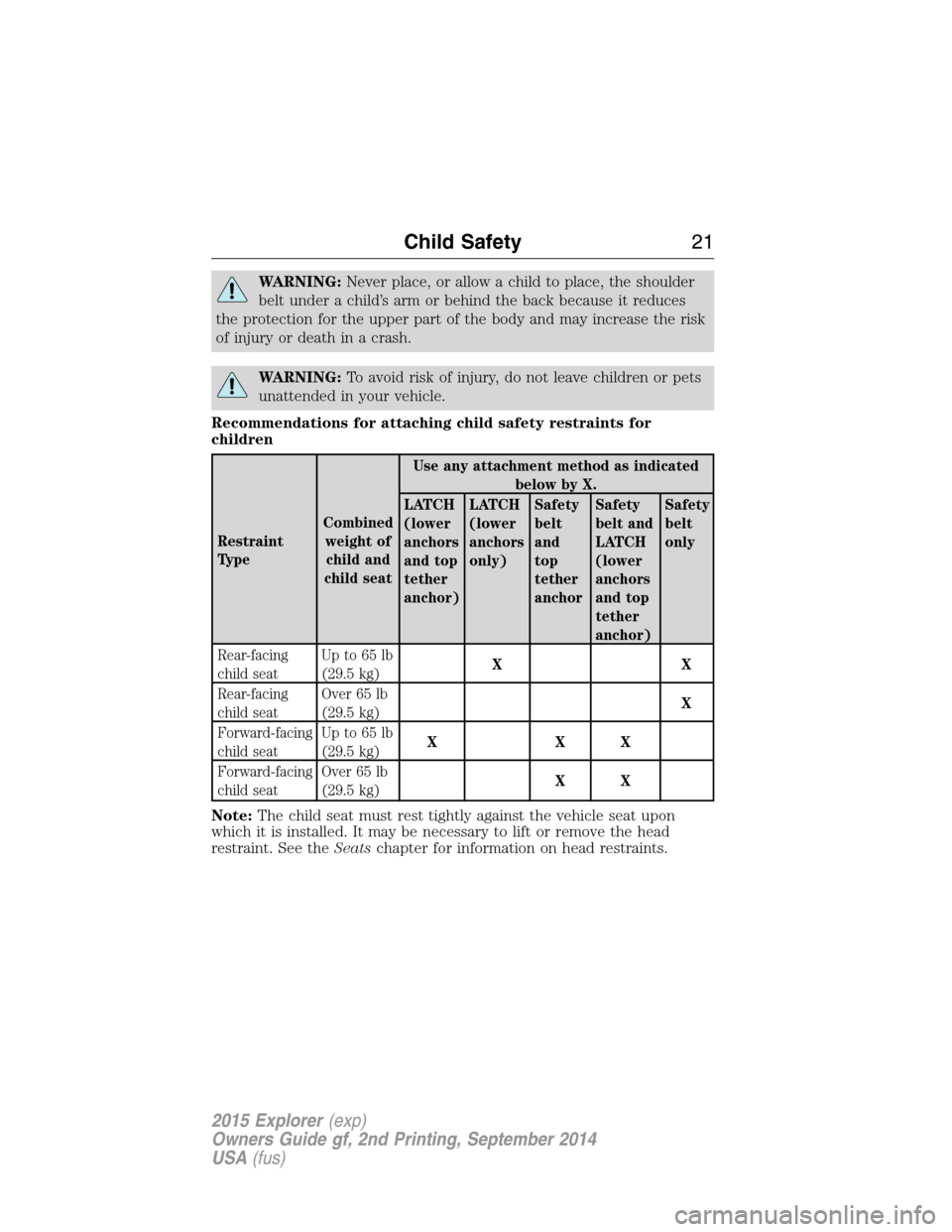
WARNING:Never place, or allow a child to place, the shoulder
belt under a child’s arm or behind the back because it reduces
the protection for the upper part of the body and may increase the risk
of injury or death in a crash.
WARNING:To avoid risk of injury, do not leave children or pets
unattended in your vehicle.
Recommendations for attaching child safety restraints for
children
Restraint
Ty p eCombined
weight of
child and
child seatUse any attachment method as indicated
below by X.
LATCH
(lower
anchors
and top
tether
anchor)LATCH
(lower
anchors
only)Safety
belt
and
top
tether
anchorSafety
belt and
LATCH
(lower
anchors
and top
tether
anchor)Safety
belt
only
Rear-facing
child seatUp to 65 lb
(29.5 kg)XX
Rear-facing
child seatOver 65 lb
(29.5 kg)X
Forward-facing
child seatUp to 65 lb
(29.5 kg)XXX
Forward-facing
child seatOver 65 lb
(29.5 kg)XX
Note:The child seat must rest tightly against the vehicle seat upon
which it is installed. It may be necessary to lift or remove the head
restraint. See theSeatschapter for information on head restraints.
Child Safety21
2015 Explorer(exp)
Owners Guide gf, 2nd Printing, September 2014
USA(fus)
Page 26 of 596

INSTALLING CHILD SEATS
Child Seats
Use a child safety seat (sometimes
called an infant carrier, convertible
seat, or toddler seat) for infants,
toddlers or children weighing
40 pounds (18 kilograms) or less
(generally age four or younger).
Using Lap and Shoulder Belts
WARNING:Airbags can kill or injure a child in a child seat.
Never place a rear-facing child seat in front of an active airbag. If
you must use a forward-facing child seat in the front seat, move the
seat upon which the child seat is installed all the way back.
WARNING:Airbags can kill or injure a child in a child seat.
Children 12 and under should be properly restrained in the rear
seat whenever possible.
WARNING:Depending on where you secure a child restraint,
and depending on the child restraint design, you may block
access to certain safety belt buckle assemblies or LATCH lower
anchors, rendering those features potentially unusable. To avoid risk of
injury, occupants should only use seating positions where they are able
to be properly restrained.
When installing a child safety seat with combination lap and shoulder
belts:
•Use the correct safety belt buckle for that seating position.
•Insert the belt tongue into the proper buckle until you hear a snap
and feel it latch. Make sure the tongue is securely fastened in the
buckle.
Child Safety25
2015 Explorer(exp)
Owners Guide gf, 2nd Printing, September 2014
USA(fus)
Page 27 of 596
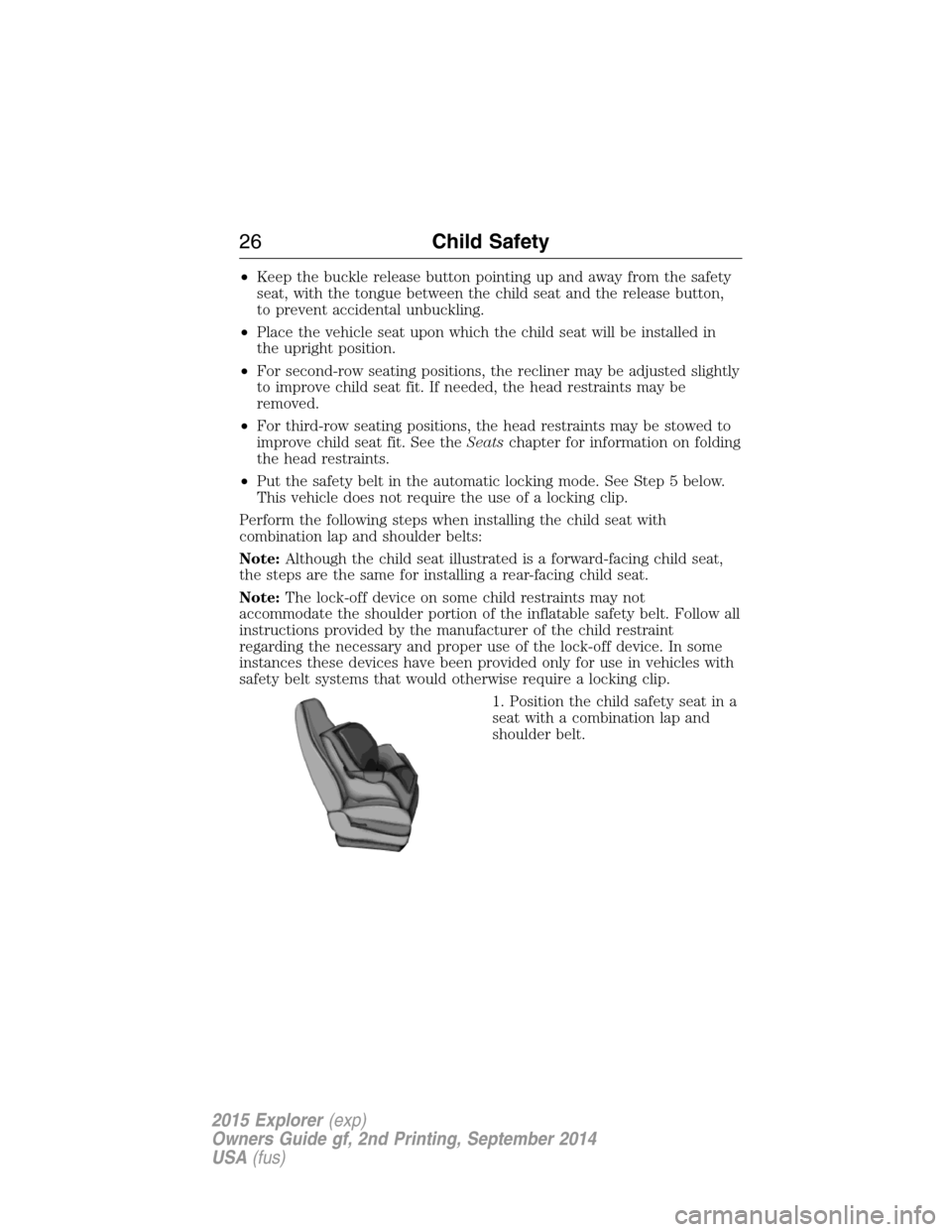
•Keep the buckle release button pointing up and away from the safety
seat, with the tongue between the child seat and the release button,
to prevent accidental unbuckling.
•Place the vehicle seat upon which the child seat will be installed in
the upright position.
•For second-row seating positions, the recliner may be adjusted slightly
to improve child seat fit. If needed, the head restraints may be
removed.
•For third-row seating positions, the head restraints may be stowed to
improve child seat fit. See theSeatschapter for information on folding
the head restraints.
•Put the safety belt in the automatic locking mode. See Step 5 below.
This vehicle does not require the use of a locking clip.
Perform the following steps when installing the child seat with
combination lap and shoulder belts:
Note:Although the child seat illustrated is a forward-facing child seat,
the steps are the same for installing a rear-facing child seat.
Note:The lock-off device on some child restraints may not
accommodate the shoulder portion of the inflatable safety belt. Follow all
instructions provided by the manufacturer of the child restraint
regarding the necessary and proper use of the lock-off device. In some
instances these devices have been provided only for use in vehicles with
safety belt systems that would otherwise require a locking clip.
1. Position the child safety seat in a
seat with a combination lap and
shoulder belt.
26Child Safety
2015 Explorer(exp)
Owners Guide gf, 2nd Printing, September 2014
USA(fus)
Page 33 of 596
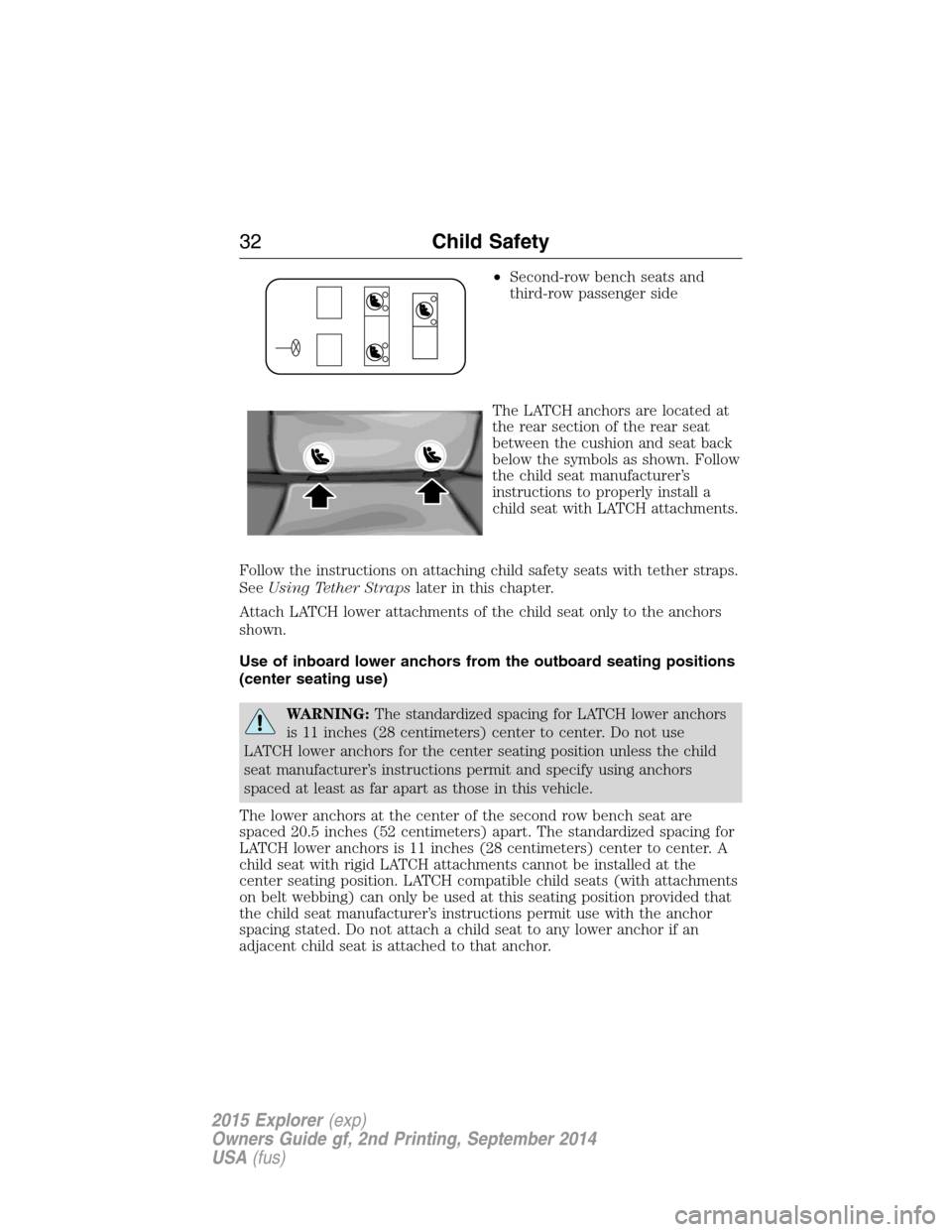
•Second-row bench seats and
third-row passenger side
The LATCH anchors are located at
the rear section of the rear seat
between the cushion and seat back
below the symbols as shown. Follow
the child seat manufacturer’s
instructions to properly install a
child seat with LATCH attachments.
Follow the instructions on attaching child safety seats with tether straps.
SeeUsing Tether Strapslater in this chapter.
Attach LATCH lower attachments of the child seat only to the anchors
shown.
Use of inboard lower anchors from the outboard seating positions
(center seating use)
WARNING:The standardized spacing for LATCH lower anchors
is 11 inches (28 centimeters) center to center. Do not use
LATCH lower anchors for the center seating position unless the child
seat manufacturer’s instructions permit and specify using anchors
spaced at least as far apart as those in this vehicle.
The lower anchors at the center of the second row bench seat are
spaced 20.5 inches (52 centimeters) apart. The standardized spacing for
LATCH lower anchors is 11 inches (28 centimeters) center to center. A
child seat with rigid LATCH attachments cannot be installed at the
center seating position. LATCH compatible child seats (with attachments
on belt webbing) can only be used at this seating position provided that
the child seat manufacturer’s instructions permit use with the anchor
spacing stated. Do not attach a child seat to any lower anchor if an
adjacent child seat is attached to that anchor.
32Child Safety
2015 Explorer(exp)
Owners Guide gf, 2nd Printing, September 2014
USA(fus)